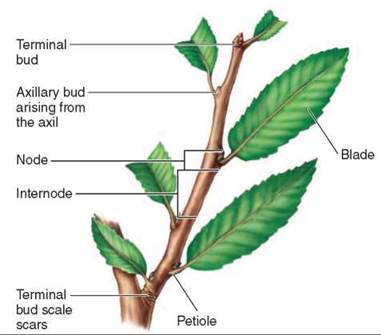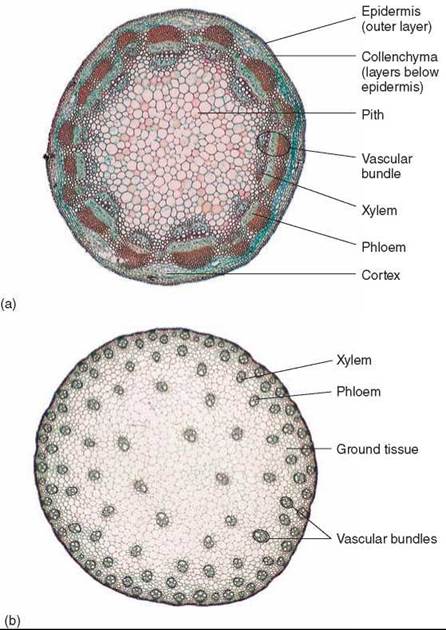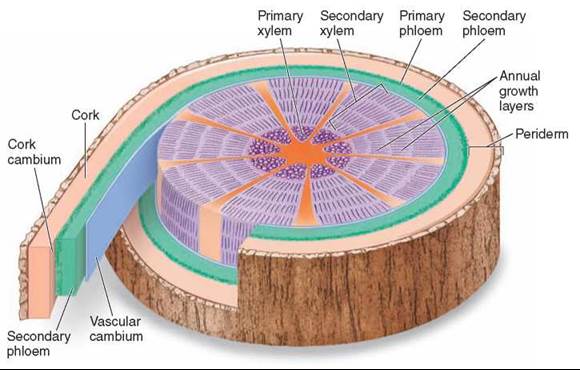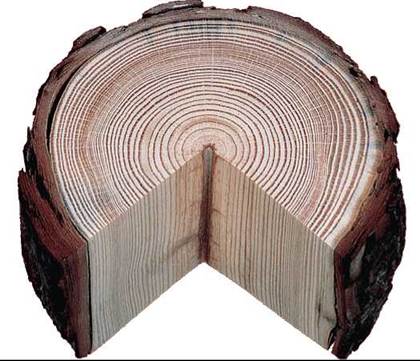THE LIVING WORLD
Unit Seven. Plant Life
33.4. Stems
Stems serve as the main structural support of the plant and the framework for the positioning of the leaves. Often experiencing both primary and secondary growth, stems are the source of an economically important product—wood.
Primary Growth
In the primary growth of a shoot, leaves first appear as leaf pri- mordia (singular, primordium), rudimentary young leaves that cluster around the apical meristem, unfolding and growing as the stem itself elongates. The places on the stem at which leaves form are called nodes (indicated by the small bracket in figure 33.4). The portions of the stem between these attachment points are called the internodes (the larger bracket). As the leaves expand to maturity, a bud—a tiny undeveloped side shoot—develops in the axil of each leaf, the angle between a leaf and the stem from which it arises. These buds, which have their own immature leaves (shown in figure 33.4), may elongate and form lateral branches, or they may remain small and dormant. A hormone moving downward from the terminal bud of the shoot continually suppresses the expansion of the lateral buds in the upper portions of the stem. Lateral buds begin forming lower down when the stem lengthens to the point where the amount of hormone reaching the lower portion of the stem is reduced, or if the terminal bud is removed, such as when you prune a plant.

Figure 33.4. A woody twig.
This twig shows key stem structures, including the node and intemode areas, the axillary bud in the axil, and leaves.
Within the soft, young stems, the strands of vascular tissue, xylem and phloem, are arranged differently in dicots versus monocots. In dicots, the vascular bundles contain xylem and phloem and are arranged around the outside of the stem as a cylinder (figure 33.5a). In monocots, the vascular bundles are scattered throughout the stem (figure 33.5b). This difference in vascular tissue organization, in addition to other characteristics discussed in chapter 32, illustrates the differences between these two major groups of angiosperms. The vascular bundles contain both primary xylem and primary phloem. At the stage when only primary growth has occurred, the inner portion of the ground tissue of a dicot stem is called the pith (the center pink-stained cells in figure 33.5a), and the outer portion is the cortex (the light green-stained cells located toward the outside).

Figure 33.5. A comparison of dicot and monocot stems.
(a) Transection of a young stem of a dicot, the common sunflower, Helianthus annuus, in which the vascular bundles are arranged around the outside of the stem. (b) Transection of a monocot stem, corn, Zea mays, with the scattered vascular bundles characteristic of the group.
Secondary Growth
In stems, secondary growth (the thickening, but not the lengthening, of the stem) is initiated by the differentiation of a lateral meristem called the vascular cambium, a thin cylinder of actively dividing cells located between the bark and the main stem in woody plants. The vascular cambium develops from cells within the vascular bundles of the stem, between the xylem (the purple-colored areas in figure 33.6) and the phloem (the light green area). The cylindrical form of the vascular cambium is completed by the differentiation of some of the parenchyma cells that lie between the bundles. Once established, the vascular cambium consists of elongated and somewhat flattened cells with large vacuoles. The cells that divide from the vascular cambium outwardly, toward the bark, become secondary phloem; those that divide from it inwardly become secondary xylem.

Figure 33.6. Vascular cambium and secondary growth.
The vascular cambium and cork cambium (lateral meristems) produce secondary tissues, causing the stem's girth to increase. Each year, a new layer of secondary tissue is laid down, forming rings in the wood.
While the vascular cambium is becoming established, a second kind of lateral meristem, the cork cambium, develops in the stem’s outer layers. The cork cambium usually consists of plates of dividing cells that move deeper and deeper into the stem as they divide. Outwardly, the cork cambium splits off densely packed cork cells; they contain a fatty substance and are nearly impermeable to water. Cork cells are dead at maturity. Inwardly, the cork cambium divides to produce a layer of parenchyma cells. The cork, the cork cambium that produces it, and this layer of parenchyma cells make up a layer called the periderm (see figure 33.6), which is the plant’s outer protective covering.
Cork covers the surfaces of mature stems or roots. The term bark refers to all of the tissues of a mature stem or root outside of the vascular cambium. Because the vascular cambium has the thinnest-walled cells that occur anywhere in a secondary plant body, it is the layer at which bark breaks away from the accumulated secondary xylem.
Wood is one of the most useful, economically important, and beautiful products obtained from plants. Anatomically, wood is accumulated secondary xylem (the light purple pie-shaped areas in figure 33.6). As the secondary xylem ages, its cells become infiltrated with gums and resins, and the wood may become darker. For this reason, the wood located nearer the central regions of a given trunk, called heartwood, can be darker and denser than the wood nearer the vascular cambium, called sapwood, which is still actively involved in water transport within the plant.
Because of the way it is accumulated, wood often displays rings. The rings that you see in the section of pine in figure 33.7 reflect the fact that the vascular cambium of trees divides more actively in the spring and summer, when water is plentiful and temperatures are suitable for growth, than in the fall and winter, when water is scarce and the weather is cold. As a result, layers of larger, thinner-walled cells formed during the growing season (the lighter rings) alternate with the smaller, darker layers of thick-walled cells formed during the rest of the year. New rings are laid down each year toward the outer edge of the stem. A count of such annual rings in a tree trunk can be used to calculate the tree’s age, and the width of rings can reveal information about environmental factors. For example, the region of thinner rings could indicate a period of prolonged drought conditions that was followed by wetter years. Can you estimate the age of the tree shown in figure 33.7?

Figure 33.7. Annual rings in a section of pine.
To test your understanding of how they form, answer this question: Are the broad inner rings older or younger than the narrow outer rings?
Key Learning Outcome 33.4. Stems, the aboveground framework of the plant body, grow both at their tips and in circumference.